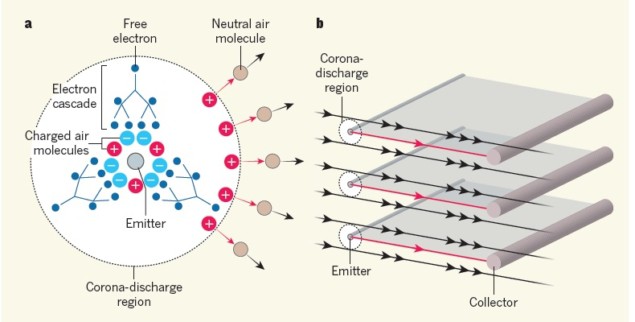More than a century after the first controlled sustained flight of a heavier-than-air aircraft, aviation remains a noisy and heavily polluting business. With altitude effects exacerbating the environmental impact of emissions, mounting concerns over the carbon footprint have accompanied the rise in international travel and plane use. Drones tipped for increased use in coming years, particularly in urban areas to exploit their agility for traffic and air pollution monitoring, use the same propeller thrust as conventional planes and are prone to the same noise – a low hum that could rapidly grate as numbers increase. Is there another way? According to demonstrations of combustion-less propeller-less aeroplane flight at Massachusetts Institute of Technology (MIT) in the US, there is.
“This all started about eight or nine years ago,” said Steve Barrett, professor of aeronautics and astronautics at MIT, at a press conference on the recently reported breakthrough. “Looking back to my childhood I was a fan of Star Trek, and at that time the future looked like it should be planes moving silently with no moving parts – maybe a blue glow but certainly no propellers or turbines or anything like that. So I started looking for what physics would make flight with no moving parts possible and came across a concept called ionic wind.”
Ionic wind first made an appearance in a paper in the 1920s. Following a decades-long lag there was a second round of interest in the 1960s when it was written off as an unviable option for sustaining flight of a heavier-than-air aircraft. Barrett and his research group picked up the baton in the late 2000s and discovered a regime that did not feature in the original paper, and which showed much more promise for providing the thrust to fly a plane.

Beyond the lithium-ion battery
Conveniently in the intervening decades the requisite electronics for invoking ionic wind to fly a plane have also come a long way. As Dave Perreault, professor of electrical engineering at MIT points out, in the 1960s the transistor had only just been invented. A plane using ionic wind for thrust needs a number of electronic components in particular a power conversion system, which Perreault was tasked with making as light as possible. Fifty years ago not only were power converters cumbersome and heavy, but battery power was more limited. The progress in battery power density since is evident in the rise of other battery-powered vehicles such as electric cars. “I think this is a piece of a broader revolution that you’re seeing in terms of moving towards electrification for all kinds of transport,” says Perreault.

The ion age of flight
The ionic wind that powers the plane is generated by electroaerodynamics. An electric field ionizes atoms and molecules in the ambient fluid – such as nitrogen molecules in air – and then accelerates them by Coulomb force. The accelerated ions then couple their momentum with other neutral atoms or molecules they collide with, and this gives rise to the ionic wind.
In their electroaerodynamic plane the MIT researchers used electrodes shaped as filaments set at a +20,000 V at the front of the plane, which accelerate ions to aerodynamic foil-shaped opposing electrodes at -20,000 V sending an ionic wind towards the back of the plane. They then applied geometric programming to their design, an approach often used to optimize a given parameter for conventional aircraft. Barrett and colleagues used it to optimize the design of their plane for minimum wing span, which corresponds to a minimum aircraft weight. The result was a 5 m wingspan plane, which the researchers made from a combination of traditional materials – such as balsa wood and foam – and more high-tech carbon fibres and Kevlar.
The plane was powered by 54 3.7-V E-Flite 150 mAh lithium-ion polymer cells. Perreault describes the strategy for lightweight power conversion to achieve the 40,000 V potential difference as like using a thimble instead of a bucket to move water. A thimble may carry less but you can shuttle it to and fro with a higher rate of repetitions and keep size and mass to a minimum. Similarly the power conversion system in the electroaerodynamic plane takes advantage of higher frequencies.
The researchers tested the plane in a 60 m long gym. As Barrett put it, trying to get permission from the aviation authorities to fly an untested plane design powered by a 40,000 V electric field outdoors was unlikely to meet with success. Still the researchers were able to demonstrate controlled sustained flight of a heavier-than-air aircraft powered by ionic wind over 45 m.
the future looked like it should be planes moving silently with no moving parts
Sustained and sustainable flight
The electroaerodynamic solid-state plane meets Barrett’s Star Trek-inspired prerequisites of silent flight with no moving parts or combustion engine. However, questions remain as to how it would cope with outdoor weather conditions and the net benefit for the environment.
Further tests are needed but it is possible the plane would cope with turbulence as well as conventional planes and may even benefit from avoiding the surge and stall mechanisms they are prone to. It is also possible that high precipitation levels may also be an advantage but again further tests are required. In addition, another research group at MIT is working on ways to make conventional planes potentially immune to lightning strikes and the researchers could apply those techniques to their solid-state plane.

While there are environmental benefits from a combustion-free plane, Barrett flags up that the ionized nitrogen chemistry could lead to production of nitrogen oxide and ozone. Further studies are needed to establish what risks this poses and whether, as in combustion cars, mitigating technology can reduce this production to acceptable levels. From an energy saving point of view the electroaerodynamic plane is battery powered and so does not benefit from getting lighter during journeys as planes using up fuel do. The benefits of zero combustion emissions could outweigh this but for now the pros and cons are still in the balance.
What this kind of solid-state alternative to combustion engines does lend itself to is scaling down so it may be ideal for drones and small aircraft with applications that have not yet been thought of. For now the immediate benefits are apparent in larger aircraft so the focus is on attempts to scale up and determining whether there are any fundamental limits to the size and mass of an electroaerodynamic plane.
Olivier Praud, a researcher at Institut de Mécanique des Fluides de Toulouse in France – who was not involved in the current work but whose work on electrohydrodynamic ionic wind the researchers drew on to develop their electroaerodynamic plane – says:
“The physical mechanism behind ionic wind, which relies on the electrostatic air acceleration, has been known for a long time. However its poor electric-to-kinetic energy conversion efficiency (only a few per cent) remained a strong limitation for practical application. Using recent aircraft design algorithm and what is actually technologically possible using current materials and power electronics technology, the authors demonstrate that ionic wind propulsion could nowadays provide an alternative method of propelling planes into the air that does not require moving parts or combustion.
“Can ionic-wind propulsion fly conventional aircraft is still an open issue and improvement of the author propulsion system are certainly required, but the breakthrough toward future applications has been accomplished.”
Full details are reported in Nature.



